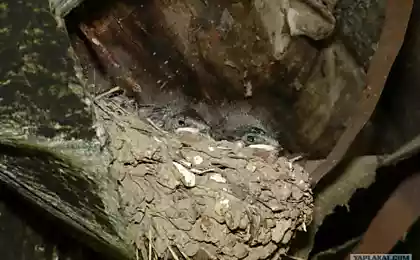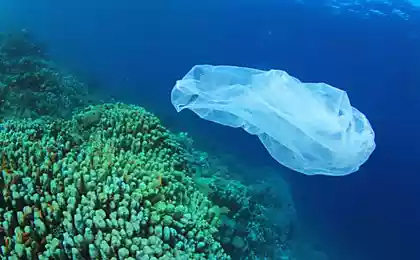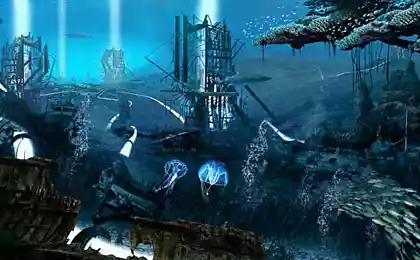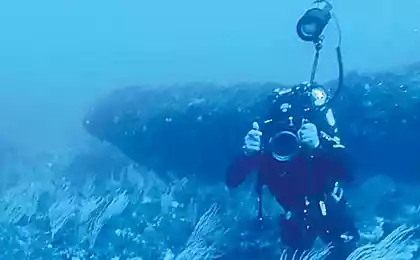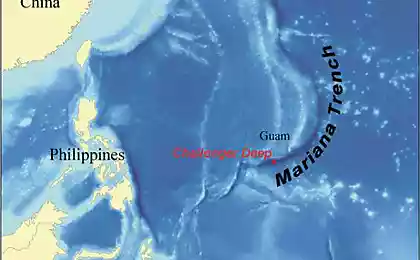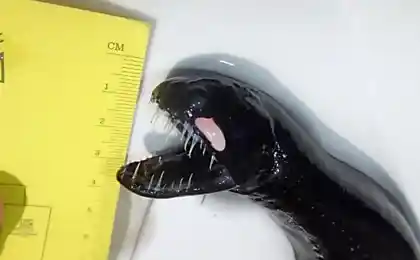880
Oceanographers caught kalminoga
Raised from a depth of about one kilometer being turned about 30 cm in length. "Oktokalmar" or "kalminog" is painted in a deep ruby color. He has eight tentacles, the head of the octopus and squid mantle (recall that the squid - decapod cephalopods, while the octopus legs, of course, eight).
Shellfish lived on the surface of another three days after the killing, as living at much higher pressure (at a depth of one kilometer pressure is about one hundred atmospheres). The body "kalminoga 'frozen for further research.
Richard Young, a professor of oceanography at the University of Hawaii, took the creature to the genus Mastigoteuthis - that is, to one of the families of squid (Teuthis), but what is actually in front of us: the new eight legged kind or just an anomaly in an individual representative - will show further research.
In 2007, it is not the first sensational scientific news from the world of deep-sea squid. In February, the Japanese managed to shoot Hydrobiology, these animals are hunted.
A team of scientists led by Dr. Tsunemi Kubodera of the National Science Museum, Tokyo, recorded on camera peculiar light show that makes the squid species Taningia danae in the northern waters of the Pacific Ocean near the island Chichidzhima. According to scientists, the animal uses a bright light during the hunt for the production of disorientation.
This type of squid can reach two meters in length. It is quite deftly moves in the water. Shots made by scientists at the depth of 240 to 940 meters, show that this type of squid are able to reach speeds of up to 2, 5 m / s at a time when he grabs the victim by all eight tentacles.
"No one has yet to watch the bioluminescence during hunting huge deep-water clam" - said Kubodera. According to him, a short, but extremely bright flashes of light that blinds squid victims are generated by special bodies, photophores, located on the tentacles of an animal with a separate circulation. The light produced by shellfish, can perform several functions. First, he confuses the victim, no matter how it is protecting. Second, illumination helps to navigate the depths of space and cephalopods by giving them a more accurate distance information to the victim. Finally, according to Dr. Kubodera, flashes of light can serve another purpose: they can be used as part of the squid courtship.
Shellfish lived on the surface of another three days after the killing, as living at much higher pressure (at a depth of one kilometer pressure is about one hundred atmospheres). The body "kalminoga 'frozen for further research.
Richard Young, a professor of oceanography at the University of Hawaii, took the creature to the genus Mastigoteuthis - that is, to one of the families of squid (Teuthis), but what is actually in front of us: the new eight legged kind or just an anomaly in an individual representative - will show further research.
In 2007, it is not the first sensational scientific news from the world of deep-sea squid. In February, the Japanese managed to shoot Hydrobiology, these animals are hunted.
A team of scientists led by Dr. Tsunemi Kubodera of the National Science Museum, Tokyo, recorded on camera peculiar light show that makes the squid species Taningia danae in the northern waters of the Pacific Ocean near the island Chichidzhima. According to scientists, the animal uses a bright light during the hunt for the production of disorientation.
This type of squid can reach two meters in length. It is quite deftly moves in the water. Shots made by scientists at the depth of 240 to 940 meters, show that this type of squid are able to reach speeds of up to 2, 5 m / s at a time when he grabs the victim by all eight tentacles.
"No one has yet to watch the bioluminescence during hunting huge deep-water clam" - said Kubodera. According to him, a short, but extremely bright flashes of light that blinds squid victims are generated by special bodies, photophores, located on the tentacles of an animal with a separate circulation. The light produced by shellfish, can perform several functions. First, he confuses the victim, no matter how it is protecting. Second, illumination helps to navigate the depths of space and cephalopods by giving them a more accurate distance information to the victim. Finally, according to Dr. Kubodera, flashes of light can serve another purpose: they can be used as part of the squid courtship.


